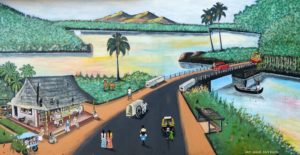Happy New Year!
It is a pleasure to begin this year on a promising note. As you all know, Ala has carried short editorials in the past to celebrate special issues as well as announce new additions. This year, we intend to make the editorial a regular feature at Ala and continue the tradition forward. We hope that the editorial will serve as a quick overview of the issue and provide a link map to other relevant stories.
In this 64th Issue, we are particularly excited to share our first article on the sporting culture in Kerala. In Amritha Mohan’s visually-rich dispatch on women’s football in Kerala, Mohan shares her disappointment at witnessing the understated fanfare around the Women’s Premier league in Kerala. As an ethnographic reflection, Mohan’s article also pays attention to her positionality as a researcher and a spectator.
Nehal Ahmed’s deeply evocative account of watching Malabari films as the son of a Gulf migrant from Bihar attends to the gulf intimacy that Malayalam cinema offers. Through his careful exploration of films such as Pathemaari (2015) and Varavelpu (1989), Ahmed walks us through his father’s life as a Gulfkaaran. The piece is also a story that can be read alongside one of our earliest publications where Mohamed Shafeeq Karinkurayil asked us to reimagine migration through the everyday personal stories of those who travel. May Joseph’s memorable account where she narrates her family’s forced displacement from Tanzania and attends to the history of migration between Kerala and Tanzania may also be useful to read in this context.
Finally, Mohammed Sadiq K’s article presents a unique and challenging historical account of Tirurangadi. Through first-hand oral narratives, Sadiq documents a rich and compelling portrait of the region and its people. Sadik’s article too can be read in conversation with some of our earlier publications. Much like C. K. Ramachandran’s piece in our 35th issue, Sadiq’s writing compels us to rethink how we understand and study the region of Malabar. For her illustration, Archana Ravi referred to real-life architectural examples, much like those featured in Radhika K.M.’s beautiful sketch series.
Happy reading!

